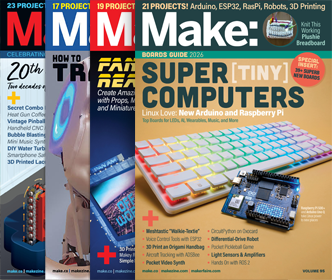I build, therefore I am. I am serial builder of things with more projects than time (I am a flight instructor and I am building a full size 2-seater airplane in the garage). In addition to flying, I enjoy model rocketry ( I 3D print some of my designs) and the Martial Arts.
View more articles by Samer NajiaI have always liked tanks (Armored Fighting Vehicles or AFVs for all you fellow purists out there) as they have always held a certain fascination for me. In my opinion, playing with tanks is only second to all things aviation in terms of fun. I have amassed a sizable collection of scale plastic models of AFVs (mostly in 1/35th scale), and over the decades have built far more than I have currently sitting in my display case. Although I am most passionate with German WW2 armor, anything from Armored Personnel Carriers (APCs) to heavy tanks hold my attention. I am less interested in their destructive power, and more in their engineering and how well they traverse terrain. I like to learn how they work.

When I read an article online about an electric tank, I immediately struck up a conversation with its maker: Brian Bunnell. I told Brian I was converting my Go-Kart to a Half Track and had been looking for suitable tracks. Our conversation turned into an all-out exchange of ideas and, before long, Brian had some wheel drawings sent my way to look at. His selection posed the ideal solution. Better yet, the vendor of the tracks (actually a conveyor belt) also offered sprockets. That gave me what I needed to get my tank idea underway.
The year before, I featured a Flight Simulator made from the fuselage of an airplane I had been working on (and later abandoned due to excessive corrosion) at the NoVa Mini Maker Faire. The sim was dismantled after the Faire and the fuselage was just sitting in my garage. Brian wanted it, so he came up to the DC area for a visit and picked it up. He also brought his tank to show me. That allowed me to inspect his drive system first hand.

The Go-Kart body for my tank was originally completely made of aluminum. The Kart could do 30mph on a 4.5HP motor. When I loaned it to a group of engineering students I was mentoring at a local college as a teaching aid, they sent me one with an entirely wooden frame. I decided to rebuild my Go-Kart with a mixture of materials. The first all metal version was dismantled. Using most of the same parts, I rebuilt most of the metal body and sacrificed an old IKEA cabinet, that did not survive our last house move, to be its floor and seat.


Initially, I intended to stick with a pure half-track that used the IntraLox sprockets. That meant trying to bolt on the sprockets to a suitable axle. Unfortunately, the bore of these sprockets is very large (1.25 inches) and I would have to put together some sort of jackshaft to get it working. It quickly became clear that the gasoline motor had to go if I wanted to reduce complexity. I got my hands on a pair of 1000W, 48V electric scooter motors. I wanted the driver to be able to steer using both the front wheels and differential braking. I could achieve this with throttles on each motor.

I chose a triangular drive system to save space and keep things light. However, in hindsight, I really overbuilt this when I chose a set of 1.25 inch threaded rods as axles. The back of this thing was heavy. It was going to be a challenge to get the tank rolling over messy terrain.

In addition to being heavy, I had to contend with fabricating an adapter for the drive sprocket to fit the drive motors. I also noticed that the amount of track making contact with the ground was very little. That meant that while I did have decent traction on terrain, it was not a whole lot. I agonized over the problem for weeks, before finally having another chat with Brian. I decided to go back to the drawing board. For research, I read the article Brian wrote for Make: on his tank.

As much as I loved this tank, I wanted bigger. Big enough for an adult and, most importantly, big enough to put a shovel on the front and plow my driveway whenever we get snowed in. It had to be a full tank and it had to be a monster.
I tore the Go-Kart Half-Track apart and removed everything but the seat and the rear axle. I then used a Waterjet Machine to make road wheels out of 6mm aluminum. I decided to use road wheels instead of fixed support like Brian’s smaller tank because I eventually wanted to add a suspension system (v1.5!). I chose the number of wheels based on just empirical testing of how much play the track contacting the ground would have from side to side (and therefore tend to come off the wheels). I settled on four wheels per side and spaced them enough to allow for some movement without completely coming off the track. Because my road wheels are also sprockets, retention of the track is positive all the time.

In the end, I actually cut sixteen wheels so that each wheel was made of two smaller wheels. I modified Brian’s drawing to key the holes in the wheels to make sure they lined up. The nuts, bolts, washes, and bushings all came from Home Depot. I used commonly available components to limit the extensive machining as much as possible. I also cut a pair of sprockets that were exactly the same as the road wheels, but had a smaller central hole to fit the motor. I had a pair of aluminum hubs I bought from DFRobotics (I think), to put on the drive sprockets.

I wanted the space under the frame to be hollow so that I could also install batteries and possibly another motor and a mower blade (to turn my tank into a snow plow-mower). So I used pillow block bearings to hold the wheels on the frame. As I did not have a through axle, I needed two bearings per wheel. Since the pillow blocks are self-aligning, it was difficult to keep the wheels upright by just using one per wheel and not have a through axle. I had completely forgotten that aspect of the bearings when I decided to use them. However, I was able to eventually do it!

That’s sixteen bearings! Can you say “monster?” I also had some 2×4 studs left over from remodeling our basement which I used to mount a set of bearings on. I needed to extend the frame sideways by, you guessed it, 1 inch on each side. I screwed those in before I mounted the bearings.

The next issue I had to deal with was removing excess track links. If IntraLox had a special tool I could have used, I knew nothing about it. Brian developed something that worked like a gear puller, but since I could not get one put together with the materials I had on hand, I had to improvise.

First, I tried banging the pins out while holding the links together with a hardened steel rod and a hammer. That helped, but the impact eventually destroyed one of the links. I found that if you roll up the track tightly, it is self-supporting. If you applied a force on its side, it would not move. So I chucked the same piece of steel rod into my drill press, marked which link I needed to remove, and rolled up the track on top of the press’s table. I then used the drill press as a sort of manual press and was able to push link pins out with the greatest of ease!
It wasn’t long before I had one side of the running chassis finished. I stepped back and realized Brian had to see a picture!

Once I had the tracks in place and the motors installed, I found that it didn’t take much motion to throw a track. No matter how tight the tension was on the track, there was always enough slack for the track to fly off even when just pushing the tank on my garage floor. I had known about sprung bogies, rollers, and tensioning systems, but I just had not considered I would need one here because I thought I did not have suspension that would introduce slack dynamically. I, of course, was totally wrong.
Worse, it turned out that the track was uni-directional. If I put the motors in reverse, the tank would throw a track even faster. I had not noticed the very tiny “Run” molded on each track link when I was working with it.
After some thinking, I inverted a simple sprung bogie to create my tensioning system out of a BMX bike shock (from a kid’s bike), some pieces of angle, and a piece of scrap square tubing.

The wheel was provided by Brian last year and the blue bearing were 3D printed. I had been prepping for 2017’s NoVa Mini Maker Faire and didn’t have time to commercially source a bearing. I could adjust the tension by raising the piece of square tubing and drilling an appropriate hole. Once the tension was set, it could be left there.
Once the running chassis was complete, it was time to get the motors moving and the batteries installed. From there it was pure fun. I got the track running and had my nephew ride it.
I found that the payload limit is just under 150lbs. Anything more and the tank will go nowhere. This is due to the high weight of the chassis as well as the relatively low power of the motors. Carrying 150lbs of motor, batteries and accessories and 150lbs of human was pushing those poor motors to the limit.
Of course, you know what that means: I need to get bigger motors, lighten the tank, and run it on a gasoline engine. Oh and yes, make the tank much bigger.
My thanks to Brian and the folks at Make: for inspiring me and encouraging me to fulfill all my crazy dreams. Making this project a reality is a dream from my childhood, and it is only just evolving.
What will the next generation of Make: look like? We’re inviting you to shape the future by investing in Make:. By becoming an investor, you help decide what’s next. The future of Make: is in your hands. Learn More.
I build, therefore I am. I am serial builder of things with more projects than time (I am a flight instructor and I am building a full size 2-seater airplane in the garage). In addition to flying, I enjoy model rocketry ( I 3D print some of my designs) and the Martial Arts.
View more articles by Samer NajiaADVERTISEMENT












